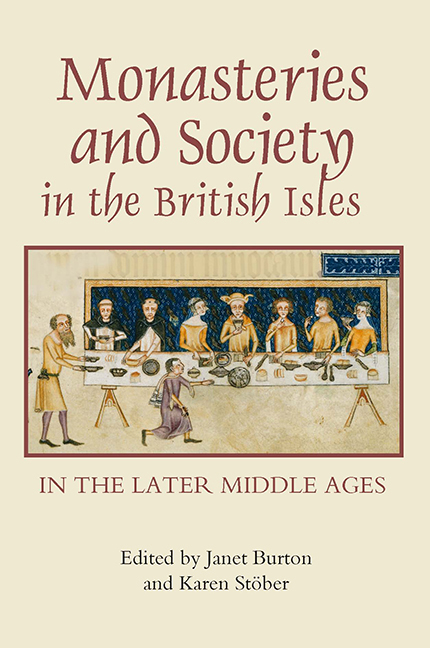Book contents
- Frontmatter
- Contents
- List of illustrations
- Acknowledgements
- List of contributors
- Abbreviations
- Introduction
- The Meeting of the Worlds
- Religious Houses and their Patrons and Benefactors
- Female Communities: Nuns, Abbesses and Prioresses
- Monasteries and Education
- Monasteries and Urban Space
- 12 Early Franciscan legislation and lay society
- 13 The Austin Friars in late medieval Canterbury: Negotiating spaces
- Religious Houses in the Regions
- Index of Religious Houses mentioned in the text
- Index
- Miscellaneous Endmatter
13 - The Austin Friars in late medieval Canterbury: Negotiating spaces
from Monasteries and Urban Space
Published online by Cambridge University Press: 24 October 2017
- Frontmatter
- Contents
- List of illustrations
- Acknowledgements
- List of contributors
- Abbreviations
- Introduction
- The Meeting of the Worlds
- Religious Houses and their Patrons and Benefactors
- Female Communities: Nuns, Abbesses and Prioresses
- Monasteries and Education
- Monasteries and Urban Space
- 12 Early Franciscan legislation and lay society
- 13 The Austin Friars in late medieval Canterbury: Negotiating spaces
- Religious Houses in the Regions
- Index of Religious Houses mentioned in the text
- Index
- Miscellaneous Endmatter
Summary
Boundaries were closely defended in late medieval towns and urban records are full of territorial disputes among individuals and institutions, who sought to guard against possible encroachments into their space. Much was at stake because control brought financial and judicial rights and privileges, issues that were of special importance to town governors and to others, including the friars, who at times resisted the demands of those in authority. Even though conflict was not inevitable, many studies of the role of urban monastic houses have highlighted the ways leading citizens attempted to wrest lordship from their powerful ecclesiastical neighbours. Other studies have considered this question of control over the spatial dynamics of the urban landscape by looking at the relationship between sacred and profane space, and the differing ways churches and other ecclesiastical buildings have been used by individuals, groups and institutions. To date some work has been done on the role of friaries in the English urban landscape, though in terms of detailed case studies the place of the London friaries has received more attention than those in provincial towns. In particular, Jens Rohrkasten's work on the London mendicants has highlighted the different experiences of the various orders both within and between towns, leading him to conclude that ‘the Orders, [though] large international structures, were highly sensitive to local influences’. This essay seeks to explore such ideas using the Austin friars of Canterbury whose history over a two hundred year period may shed further light on the place of the mendicants in provincial English society.
As Rohrkasten notes, friaries were often established in the suburbs, or close to gates or town walls and frequently adjoining a major thoroughfare, often resulting in their proximity to market places, harbours or rivers. Among the Italian friaries he sees evidence of a long-term strategy regarding their location, though how far this was replicated in England remains open to discussion, and in some cases their late arrival onto the urban scene left them few alternatives other than marginal sites. Yet aristocratic or similar patronage might provide a more central location which could result in an increasingly complex urban landscape, requiring them to negotiate their place within urban society.
- Type
- Chapter
- Information
- Publisher: Boydell & BrewerPrint publication year: 2008



